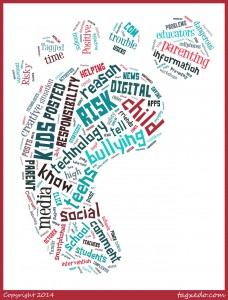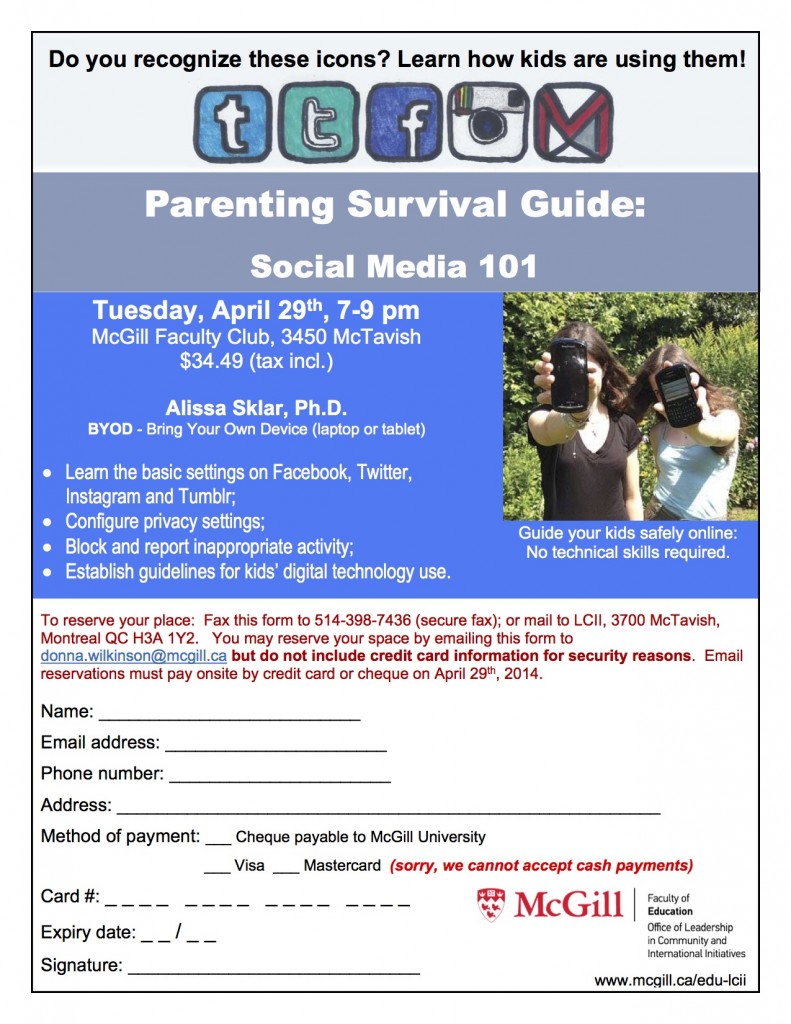 How do I keep my kids safe online? That’s the #1 question I get from parents. Educators ask a variation on the same theme: how do we teach our students to stay safe online? From Facebook to Tumblr, texting to sexting, adults spend a lot of time worrying about the ways digital technologies can get kids in trouble.
How do I keep my kids safe online? That’s the #1 question I get from parents. Educators ask a variation on the same theme: how do we teach our students to stay safe online? From Facebook to Tumblr, texting to sexting, adults spend a lot of time worrying about the ways digital technologies can get kids in trouble.
That’s important, of course, but it’s also shortsighted. In addition to preventing bullying, sexual exploitation, illegal activities and painful social dramas, we also need to teach kids how to use those technologies in productive, creative ways. We need to teach them the skills they will need to take on the jobs of the next generation. We need to show them how create and manage their online profiles – how to curate their digital footprints.
This is a completely different perspective. While today’s schools and education systems grapple with how to teach the next generation how to effectively learn and manage digital technologies, I work with educators to show them how this can be — and should — be done by strategically incorporating these tools into the curriculum rather than banning it.
The overall goal here is to help users stay on top of their presence online by actively managing it. This is true for everyone – not just kids. For adults and kids, it is critical that you not only know how you appear online, but that you take concrete steps to ensure high-quality, positive links are easy to find.
I describe this as “curating your digital footprint.” In other words, you want to take care to make your discoverable presence online as complete and helpful as possible. This will be helpful when it comes to applying for schools and jobs, student loans and scholarships. In a 2013 survey of U.S. college admissions officers, 31% admitted to checking applicants’ Facebook pages and 29% said they ran Google searches. It’s hard to imagine when you are 12 or 15, but those images and links associated with their name will still be there when they are 30 or 45.
So how do you do that? Here are some tips you can use to make sure your kids’ footprint helps to improve their image online (or at very least, not harm it). They will need your assistance to get going, but you should involve them (no matter their age), so they can learn to stay on top of this by themselves. These activities should be seen as the new digital hygiene, or personal image management.
-1- Map your existing digital footprint. Start off by Googling yourself. If you or your child use a nickname most of the time, that’s the name you should check. The links that come up in the first page can be considered your “Google home page.” These are what people are most likely to see if they search for you. Also check Bing and Yahoo, because their search engines may turn up different results. YouTube is the world’s second most popular search engine – be sure to check there too.
-2- Now take a closer look at the links you find on the first few pages. Then look back at the next 4 pages and scan all the links (few users will be motivated to go back further than that). Click at the “Images” link at the top of the search results, and make sure you are familiar with the images that get associated with your name. I recently heard from a mom who’s daughter had posted a picture of herself online in a revealing outfit. She had grudgingly conceded the photo was OK because she had set the privacy control so only a few girlfriends could see it. The she heard from the mother of a teenage boy who was upset to find the inappropriate photo on his phone. It seems someone had used “print screen” to grab the image and posted it on another website with the girl’s name. And despite frequent attempts to do so, they have not been successful in getting the image removed. Remember that any protective features on digital tools (privacy settings, or videos set to delete after a few seconds) are totally illusory. Someone, somewhere will figure out a way around it. Rule of thumb: if you don’t want everyone to see it, don’t post it in a digital format. (Click here to tweet this.
Review the links to see if they tell story story with which you are comfortable. Ask your child, is this what you want searchers to find? Would they be OK if their grandmother saw those links and pictures? Their algebra teacher? The person interviewing them for a job? The man or woman they may one day marry?
Next, look for negative associations. Are there any links that are false, untrue or negative? Are there any that are so outdated as to be potentially embarrassing? Are there any links that have your name link to someone or something else and cause potential confusion? If so, these are opportunities to make some corrections. You should attempt to contact those responsible for untrue, unflattering or embarrassing links and ask to have them removed. Do so via email instead of by telephone so you have a record of attempts to set the record straight. Sometimes that’s impossible to do, for a variety of reasons. In that case, your sole recourse may be to obscure those problematic links by burying them deep in your Google results (see #3 and #4).
-3- Work to build links to high quality content that will land at the top of your search results. In other words, actively seed the search so that positive, informative links come up first. Celebrities and brands do this all time, but individuals should do it too. This is easier than you might realize. For starters, recognize that Google’s search algorithm gives priority to Google products. That means YouTube channels and videos, Google+ profiles and Blogger blogs will always come out near the top. One of my daughters has written a young adult novel on a young writer’s social network called Wattpad that has garnered more than 50,000 reads, encouraging her to write even more. A complete LinkedIn profile for adults will also get priority listing, so it’s certainly worth taking the time to complete it.
-4- Stay on top of your digital footprint going forwards. Set up Google Alerts with your name and your organization’s name (and any other names or terms that are important for you to track), so that you will be emailed with links any time those terms appear anywhere on the public areas of the Internet. This includes any publicly accessible websites, Twitter, LinkedIn and many other social media networks, and Facebook pages with “public” profiles. Facebook accounts with privacy controls set to “private” are not accessed by Google search.
-5- Consider using available services to build and maintain your brand. Make no mistake here – kids should understand your good name is very valuable, a personal brand. If you want to be more proactive about the links that appear in search results for your name, consider ways to actively manage them. Blogs are great ways to stack good links at the top, since each post is treated by search engines as a separate indexed page. Videos, social media network accounts and organizational mentions (from your school, community theatre, hockey team, dance crew, swim team or local newspaper) can all help fill in your profile.
One service I really like is BrandYourself.com. This site was started by a guy who realized he was losing out on job opportunities because a convicted drug dealer in his region shared the same name – and was consequently, undeservedly harming his reputation. BrandYourself lets you fill out and publish a personal profile, and then analyze your Google results. You can boost links that offer informative, positive information, so that other results are pushed back down to lesser viewed pages. The service will also email you regular updates when new links or posted, or make suggestions to help manage the links that are there.
Ultimately, the message to kids, educators and parents is to focus on the whole picture. The idea isn’t just to prevent bad or embarrassing mentions, but also to fill in the good ones. Digital technologies are tremendous tools – teaching kids how to use them wisely and responsibly is in everyone’s best interests.
 When yesterday’s post about Instagram tips for parents went up, I got an email from one mom point out what I forgot to mention: direct messages. Like many social networks, Instagram offers the users the option to send private, direct messages to one or more users.
When yesterday’s post about Instagram tips for parents went up, I got an email from one mom point out what I forgot to mention: direct messages. Like many social networks, Instagram offers the users the option to send private, direct messages to one or more users. -4- Report or block abusive or inappropriate messages. You can report abusive posts that are sent to you by tapping the three dots [ . . . ] below a photo or video post. If you don’t want someone to send a post to you, you can ignore their post in your direct posts by tapping the “x” or you can block that person.
-4- Report or block abusive or inappropriate messages. You can report abusive posts that are sent to you by tapping the three dots [ . . . ] below a photo or video post. If you don’t want someone to send a post to you, you can ignore their post in your direct posts by tapping the “x” or you can block that person.


